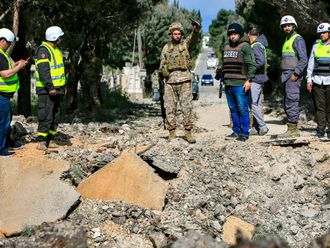Dubai: Millions of Aleppines who pride themselves on being the inventors of the supermarket concept are living their worst nightmare with their oldest traditional souq in existence, Al Madina, destroyed by fire due to the military confrontation in the city over the past two days.
Al Madina (Downtown in modern terms) was caught in the crossfire of Bashar Al Assad’s forces and the forces of the 19-month revolution against the regime.
Being a citizen of the five million populated city of Aleppo, the economic and the industrial capital of Syria, whose Bedouin ancestors opted to settle in the city some 600 years ago, I lived and grew up with an almost weekly visit to the souq to buy supplies for the family.
When I was very young, I used to go with my parents to train me on what and how to buy. At the age of 12, I started to visit the market on my own.
After I came to work in the Gulf in the 1980s, I kept up the habit of visiting the souq every time I visited the city, and the longer I stay away from Aleppo, the more I visit the market when I am there. It is in a way to compensate for missing it!
For me, visiting Aleppo is not complete without visiting Al Madina.
It is a must-visit, not only because of its nostalgic value, but simply because I buy from the shops there — items for my family that I can’t find elsewhere.
The volume of my purchases is enough to last a year. I buy special kinds of herbs and peppers or special Aleppo sweets from one specific outlet.
Literally, you can buy everything you want under one roof. From gold ornaments to socks and the pure cottons that are exported to France and other European markets in bulk quantities.
My last visit to the souq was in September 2010, just six months before the Syrian Revolution sparked against the rule of Bashar Al Assad’s regime and two years before the current disaster.
It looks like the place will never be like I knew it before.
“No Aleppine believes that the destruction of the world’s oldest market could have happened on the hand of someone who had little respect for life and history,” wrote Mazen Kharrat, a 55-year-old architect on my Facebook wall.
Many other Facebook fans, who knew the historical and economic value of the market, agreed. One of them said what is the value of the market’s history and commodities for a regime that killed more than 30,000 of its people just to stay in power.
“Al Assad will set the whole country on fire to stay in power. That is what his Shabibas chanted and wrote on the walls of the cities. Setting Al Madina souq on fire is just a symbolic testimony of the level of atrocity and disrespect for human life and the history of people,” Sahar, another Aleppine engineer wrote.
But Al Madina, which was built on a 160,000 square metre site and took its current shape some 700 years ago, is the jewel of the markets in the east by all standards.
There are more than 4,000 shops in the market’s 37 specialised souqs, they trade in products from hundreds of thousands of professionals and craftsmen of Aleppo.
Economists believe that the impact of the economic disaster over the burning of Al Madina is far beyond assessment and will leave its traces on Aleppo for years and decades to come.
The white stones used in building Al Madina souq were cut and placed some 25 centuries ago.
The recent destruction of parts of the market is not just a loss for the thousands of Aleppines who earn their living from it; but a great loss for the memories of how traditional markets were developed over history.










